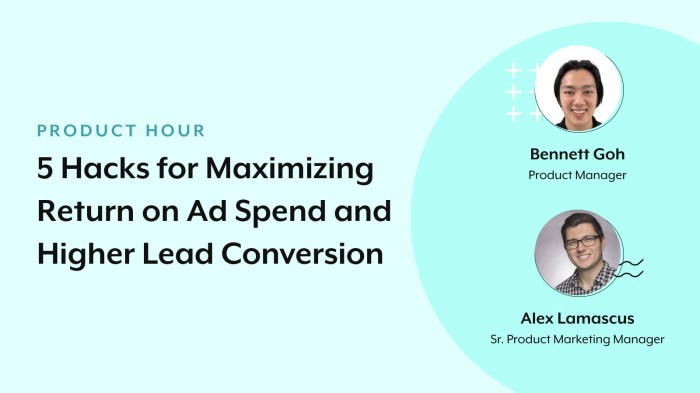Maximizing Return on Ad Spend is key to digital advertising success. Dive into the world of ROAS with a fresh perspective and uncover the secrets to boosting your ad performance.
From targeting the right audience to leveraging cutting-edge technology, this guide will show you how to take your ROAS game to the next level.
Understanding Return on Ad Spend (ROAS)
Return on Ad Spend (ROAS) is a crucial metric used in digital advertising to evaluate the effectiveness of a marketing campaign by measuring the revenue generated for every dollar spent on advertising.
ROAS is calculated by dividing the total revenue generated from the ad campaign by the total cost of the campaign. The formula for ROAS is:
ROAS = Revenue Generated / Cost of Advertising
This metric is essential for businesses as it provides insights into the profitability of their advertising efforts. A high ROAS indicates that the campaign is generating more revenue than the cost of advertising, resulting in a positive return on investment. On the other hand, a low ROAS suggests that adjustments need to be made to improve the campaign’s performance and maximize profitability.
Examples of ROAS across Different Marketing Channels
- Influencer Marketing: A company collaborates with an influencer to promote their products on social media. The ROAS can vary depending on the influencer’s reach and engagement with their audience.
- Google Ads: Running a Google Ads campaign can yield different ROAS based on the s targeted, ad placements, and relevance of the ad copy to the target audience.
- Facebook Ads: The ROAS for Facebook Ads can fluctuate based on factors like ad format, audience targeting, and the timing of the campaign.
Strategies for Maximizing ROAS

To maximize Return on Ad Spend (ROAS), it is crucial to implement effective strategies that target the right audience, optimize ad creative and messaging, and utilize data analysis to improve performance.
Targeting the Right Audience
Identifying and targeting the right audience is essential for maximizing ROAS. By understanding your target market demographics, interests, and behaviors, you can tailor your ads to reach those most likely to convert. Utilizing tools like Facebook Ads Manager or Google Ads targeting options can help narrow down your audience for better results.
Optimizing Ad Creative and Messaging
The ad creative and messaging play a significant role in impacting ROAS. Creating compelling visuals, engaging copy, and a clear call-to-action can increase conversion rates. A/B testing different ad variations can help determine which creatives resonate best with your audience, ultimately improving ROAS.
Role of Data Analysis
Data analysis is instrumental in improving ROAS performance. By tracking key metrics such as click-through rates, conversion rates, and cost per acquisition, you can identify trends and insights to optimize your ad campaigns. Utilizing tools like Google Analytics or Facebook Pixel can provide valuable data for making informed decisions to maximize ROAS.
Leveraging Technology for ROAS Optimization: Maximizing Return On Ad Spend

In today’s digital landscape, leveraging technology is crucial for optimizing Return on Ad Spend (ROAS). Let’s explore how artificial intelligence, machine learning, and automation tools play a significant role in maximizing ROAS.
Artificial Intelligence and Machine Learning, Maximizing Return on Ad Spend
Artificial intelligence (AI) and machine learning algorithms can analyze vast amounts of data to optimize ad campaigns in real-time. These technologies can predict consumer behavior, identify trends, and adjust ad targeting to maximize ROAS. By leveraging AI and machine learning, advertisers can make data-driven decisions that lead to higher returns on their ad investments.
Benefits of Automation Tools
Automation tools streamline the process of managing ad campaigns by automating repetitive tasks such as bidding, budget allocation, and performance tracking. These tools can optimize campaigns more efficiently than manual methods, saving time and resources while improving ROAS. By automating routine tasks, advertisers can focus on strategy and creative aspects to drive better results.
Popular Platforms for Maximizing ROAS
– Google Ads: Google’s machine learning algorithms optimize ad delivery to reach the right audience at the right time, maximizing ROAS.
– Facebook Ads Manager: Offers advanced targeting options and optimization features to improve ad performance and increase ROAS.
– Adobe Advertising Cloud: Provides AI-powered optimization tools to enhance ad campaigns and drive better results.
– Amazon Advertising: Uses machine learning to optimize ad placements and targeting for improved ROAS on the e-commerce platform.
Measuring and Monitoring ROAS Effectiveness
When it comes to measuring and monitoring ROAS effectiveness, there are key performance indicators (KPIs) that are crucial in evaluating the success of your advertising campaigns. These KPIs help you understand how well your ad spend is performing and whether it is generating the desired return on investment.
Key Performance Indicators for ROAS Effectiveness
- Conversion Rate: This metric measures the percentage of users who take a desired action after clicking on your ad. A high conversion rate indicates that your ad is resonating with your target audience.
- Revenue Growth: Tracking the revenue growth attributed to your advertising efforts helps you see the direct impact of your ad spend on your bottom line.
- Cost Per Acquisition (CPA): This metric calculates the cost of acquiring a new customer through your advertising campaigns. A lower CPA indicates that you are effectively converting leads into customers.
Importance of A/B Testing in Measuring ROAS Performance
A/B testing is essential for measuring ROAS performance because it allows you to compare the effectiveness of different ad creatives, messaging, or targeting strategies. By running A/B tests, you can identify which elements drive the best results and optimize your campaigns accordingly.
Tracking and Analyzing ROAS Data
Tracking and analyzing ROAS data is crucial for making informed decisions about your advertising strategy. By monitoring metrics such as conversion rates, revenue growth, and CPA, you can identify trends, spot areas for improvement, and allocate your ad budget more effectively. Utilizing tools like Google Analytics or specialized ad platforms can provide you with the data you need to measure ROAS performance accurately.
